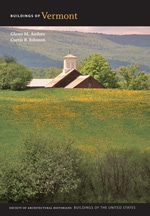
By 1800 small mineral springs at a number of sites in Vermont, among them Brattleboro, Brunswick, and Highgate, began attracting those seeking rest and cures. Clarendon Springs has the best-preserved setting and buildings of this early tourist industry. The first inn at the springs was constructed in 1798, but it was Thomas McLauglin who turned the place into a resort c. 1835 by building an impressive three-story brick hotel, an adjacent two-story stone store, and related structures. Around 1850 McLauglin added a full-front three-story porch that curves around to cover the southern gable side. The hotel developed a regular summer clientele from south of the Mason-Dixon Line, which obviously affected business during the Civil War. After this hiatus, Byron Murray and Sons revived the springs to accommodate up to 250 guests, adding more private cottages and a new spring house and other structures, notably the Second Empire “cottage” at the main intersection. As the interests of summer visitors evolved from rest to recreation over the next decades, the resort lost favor and closed in 1898. The exterior of the old hotel, with its many-columned porch and its related store and cottages, has changed little although the interior was gutted, probably in the 1970s.

